
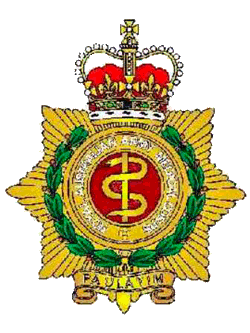
The customs and Traditions of the RAAMC can be traced back to the time of the first Fleet and embrace many of those of the RAMC. To learn more about the history of the RAAMC visit the South Australian RAAMC History Committee Web site.
Lineage of the Royal Australian Army Medical Corps (RAAMC) can be traced as far back to the First Fleet in 1788, when a medical team of five medical officers landed on our shores.
Since then the Corps has grown. There were medical staff with the New South Wales Corps and the British garrisons. When the Victorian Volunteer Artillery Regiment was raised in 1854 surgeons and assistants were recruited to tend to the sick and wounded. The NSW regular force enrolled in 1870 included medical staff. In 1885 the first contingent of medical personnel was dispatched the Sudan Campaign.
The years between 1899 and 1902 brought some significant changes within the corps. The South African War broke out in 1899 and the Australian Colonies equipped several contingents for the war. On the 24 July 1900 Captain Neville Howse was the first Australian soldier awarded the VC.
With federation in 1901 Colonel Williams was recalled from South Africa to form the Medical Corps. He was appointed the first Director General of Medical Services on 1 April 1902.
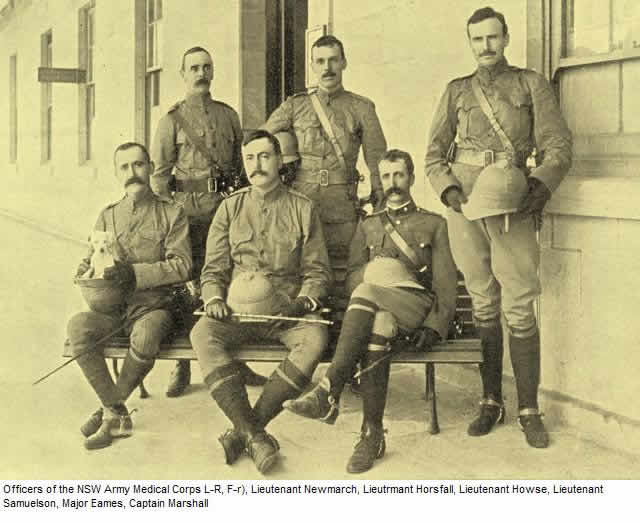
The Commonwealth Government gazette of 23 Nov 1902 stated that the medical services in each state were to be dealt with as one Corps and on 1 July 1903 and the Australian Army Medical Corps (AAMC) was formed.
In 1914 with the outbreak of WW1 the AAMC comprised of 187 Officers and 1680 other Ranks.
Since WW1 the Medical Corps has provided support for every action and peacekeeping mission where Australian soldiers Australia have been committed. There have been many brave and self sacrificing actions by Army medical staff Private John "Simpson" Kirkpatrick at Gallipoli and Weary Dunlop in Burma to mention but two.
The RAAMC (made "Royal" in 1948) still serves today in many campaigns across the world with the same honour, loyalty and dedication.
This Web Site has been designed to provide the latest information of activities and developments within the Corps. The information is regularly updated so please visit frequently.
A detachment of the Royal Marine Light Infantry arrived with the first fleet at Sydney Cove in 1788. It is amongst these infantrymen that the proud history of the RAAMC begins. A part of this light infantry was a medical team of five Medical Officers under the supervision of principal surgeon John White.
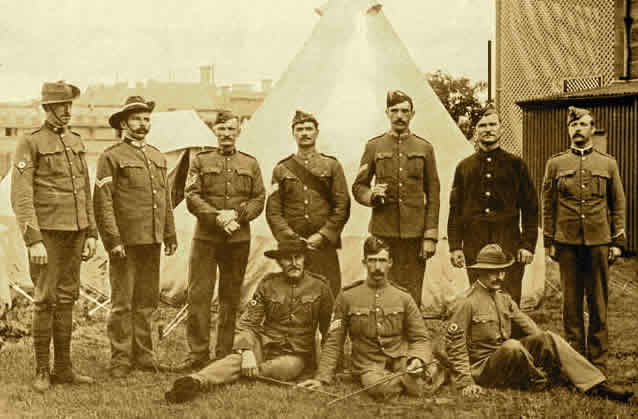
Non Commissioned Officers of the NSW Army Medical Corps
With the arrival of the second fleet in 1790, came a further group of colonists and the newly founded New South Wales Corps which replaced the Marine detachment. Their Regimental Surgeon was John Harris who took up his station at Parramatta in 1791. He has the distinction of being the first Army Medical Officer in the Colony.
Following the return to the United Kingdom of the New South Wales Corps in 1810, small British garrisons, often of only Company strength, were stationed in Sydney. Naturally other leading settlements also had the garrisons detached to their area. Each detachment was generally accompanied by their own surgeons or assistants, along with a small medical establishment. The function of the surgeons was mainly attendance of official personnel and superintendents of public hospitals.
In 1803 even though the rum traffic was rife, and the New South Wales Corps was still in power, the need to recruit local volunteers was apparent. Consequently the Loyal Sydney and Parramatta Association was raised. Medical facilities were included with this association, and others similar to it, over the next 60 years.
In Victoria in 1854 the Melbourne Volunteer Rifle Regiment, later to be known as the Victorian Volunteer Artillery Regiment, was established with a strength of approximately 2000 men, and in 1860 when the Regular British Garrison was ordered to New Zealand, it was replaced by these volunteers. These volunteer units were mainly Artillery and Infantry, and following the British pattern included medical personnel in their establishments. Thus in 1870 when a regular force was enrolled in New South Wales, it boasted a medical staff of one staff surgeon, five surgeons and eleven assistant surgeons. Likewise in other colonies, Medical Officers were recruited for part time duties.
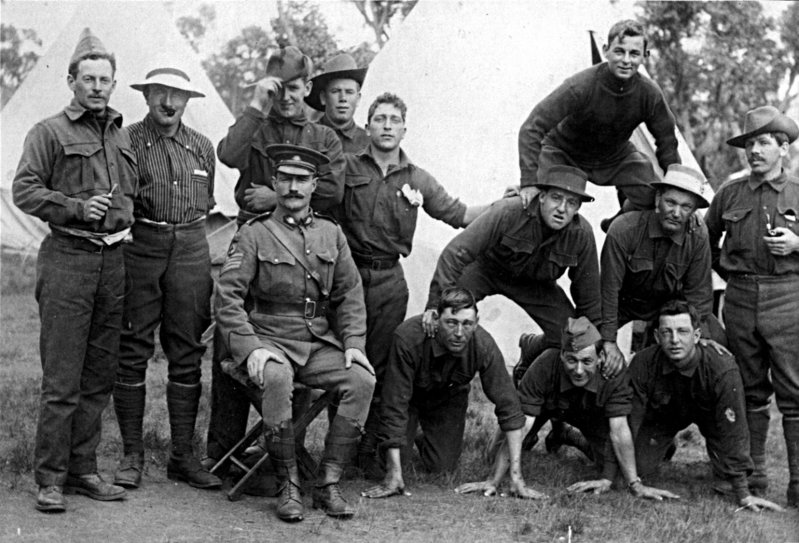
Informal group portrait of a section of the Australian 3rd Field Ambulance at
Blackboy Hill, Western Australia, October 1914.
Private John Simpson Kirkpatrick
is standing third from left, behind the seated sergeant-major.
Four of the thirteen men in the photo were killed during the Battle of Gallipoli.
Australian War Memorial catalogue number A03117
The regular force that was enrolled in NSW in 1870 consisted of one Battery and two companies of Artillery, and in 1871 Dr WJ. Bedford was appointed Staff Surgeon to this unit, becoming the first regular Australian Army Medical Officer in the defence forces of the colony.
The first hallmark in the history of the RAAMC came in 1885 when a contingent of 700 volunteers was raised in NSW to embark for South Africa and the Sudan Campaign.
Among these 700 men was an Ambulance Corps numbering 34 personnel. It included three Medical Officers. In command of this corps was Staff Surgeon W.D.C. Williams, holding the relative rank of Major. His other two surgeons holding the relative rank of Captain were Surgeons Glanville and Proudfoot. This section boasted entire self containment, with equipment such as five ambulance wagons, two store carts, a water cart, and 26 horses.
Under the guidance and enthusiasm of Staff Surgeon Williams the Medical Services in NSW grew dramatically, and on his recommendation to the Commandant of that state, in 1888 both Officers and Other Ranks were incorporated into the one organisation. The New South Wales Medical Staff Corps. This Corps consisted of one Principal Medical Officer, four surgeons, and 63 Other Ranks. The following year in 1889 Staff Surgeon Williams was appointed officially as the Principal Medical Officer and promoted to the rank of Lieutenant Colonel.
In 1891, from the ranks of the NSW Medical Staff Corps, a Permanent Staff Corps was recruited to act as a small cadre to perform administrative and instructional duties
The years between 1899 and 1902 brought about some very significant changes within the Corps. The South African War broke out in 1899 and as a consequence each Australian Colony raised and equipped several contingents for the campaign.
A total of four contingents embarked for overseas and in all, the medical support consisted of 30 Medical Officers, 338 Other Ranks, 265 horses, 16 ambulance wagons and 46 transport carts- This enabled the detachment to supply stretcher bearers and fully manned and equipped Field Hospitals.
The medical facilities came under the control of the Principal Medical Officer of the 'British Forces, who was continuously impressed with their mobility and how good and practical its equipment was.
Lord Roberts, the Commander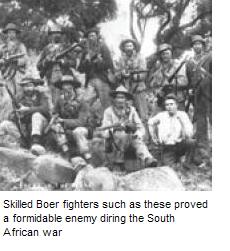 -in-Chief of the Allied Forces sent a letter of thanks to the NSW Government. This letter indicated that the units served with great distinction and courage. -in-Chief of the Allied Forces sent a letter of thanks to the NSW Government. This letter indicated that the units served with great distinction and courage.
On the 24 July 1900 at Veredefort, the first Australian Victoria Cross was awarded. It was presented to Captain N.R Howse who went out under fire, and picked up a wounded man and carried him to a place of shelter.
During the Boer War in 1901 a single Commonwealth or Federal Government was inaugurated. Colonel Williams who was then the Commander of the Medical Detachments in South Africa, was recalled to Australia to organize the Medical Corps. In 1902 he organized and dispatched to South Africa the final Medical Contingent. It comprised representatives from each state of the Commonwealth. General Routine Order No. 115 of 21 July 1902 published an extract of the Commonwealth of Australia Gazette No. 34 which provisionally appointed Colonel William Daniel Campbell Williams CB to be Director General of Medical Services effective 1 April 1902.
General Routine Order N0. 123 of 30 July 1902 promulgated that "the existing Medical Services of the various states should be organized on one similar basis and should be reconstructed and organized so as to form one Corps, the Australian Army Medical Corps, to take effect on and from 1 JulyI902".
General Routine Order No- 269 on 23 November 1903 published an extract of the Commonwealth of Australia Gazette No. 65' which stated "The whole Commonwealth or Federal Government was inaugurated of the existing Army Medical Services of each State and -will be dealt with as one Corps, and will be styled the Australian Army Medical Corps to take effect on and from 1 July 1903"
At this time the Permanent Medical Services consisted of small army cadres posted to Militia units for care of the permanent forces, maintenance of vehicles and equipment and training of personnel.
From this it is obvious that the Militia and volunteer forces provided the bulk of medical support, to the extent that by 1914 at the outbreak of World. War I, the medical services numbered as follows:
a. Permanent Force - four AAMC Officers and 29 Other Ranks; and
b. Militia and Citizen Forces - 183 AAMC Officers and 1649 Other Ranks.
This was largely brought on by the introduction of Universal Military Training in 1911.
Since the commencement of World War I, the AAMC has provided support for every action in which Australia has been committed.
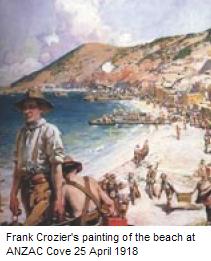 The Corps served with great distinction, courage and conviction during World War I: The Corps served with great distinction, courage and conviction during World War I:
a. 1915 - Gallipoli;
b. 1916-1918 -Palestine and Syria; and
c. 1916-1918 - France and Belgium.
In the campaign at Gallipoli the most well known of individual acts of heroism occurred. Private John "Simpson" Kirkpatrick used a donkey to carry wounded soldiers from the battlefield to the beaches for treatment and evacuation. He worked untiringly, and in appalling conditions without regard for his own safely. He was killed in the performance of his duty on 19 May 1915. The Second Australian Imperial Force was raised for service in World War 11. The medical units as part of this force served with great dedication and success in places such as: Greece, Crete, Syria, Malaya, Middle East and Papua New Guinea.
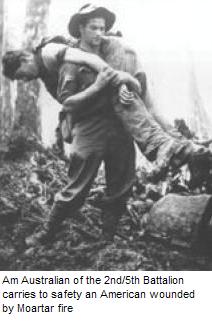
The Corps has provided medical support: in all theatres since the end of World War II serving in:
a 1950 - 53 Korea;
b 1957 - 59 The Malayan Emergency;
c 1965 - 66 The Indonesian Confrontation; and
d 1966 - 72 South Vietnam.
Since the Vietnam War RAAMC personnel have served in: Rhodesia, Namibia, The Gulf War, Northern Iraq, Sinai, Western Sahara, Somalia, Cambodia, Rwanda, Mozambique, Pakistan, Papua New Guinea East Timor, Iraq and Afghanistan.
ORDER BATTLE VIETNAM
ROYAL AUSTRALIAN ARMY MEDICAL CORPS (RAAMC)
1 Australian Field Hospital (13 November 1967 - 14 December 1971)
2 Field Ambulance (1 April 1966 - 5 July 1967)
8 Field Ambulance (2 March 1967 - 12 March 1972)
Detachment 1 Field Medical/Dental Unit (20 November 1967 - 25 November 1971)
Detachment 1 Field Medical/Dental Equipment Detachment (20 November
1967 - 25 November 1971)
Detachment 1 Field Hygiene Company (5 December 1967 - 12 March 1972)
Back to Top
|
